Dacryocystorhinostomy
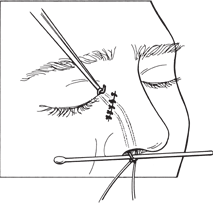
Dacryocystorhinostomy (DCR) is a drainage procedure designed to bypass the site of nasolacrimal duct obstruction by forming a fistula between the lacrimal sac and the nasal cavity. This procedure is performed in patients who have chronic epiphora or dacryocystitis secondary to complete or partial obstruction of the nasolacrimal duct. It is applicable to patients whose upper and lower canaliculi are patent but contraindicated in cases of suspected lacrimal sac malignancy. Additionally, a DCR should not be performed on a patient with acute dacryocystitis. One should wait until the infection has been cleared and for an opportunity to reassess the patient’s symptoms and patency of the lacrimal drainage system.
PREOPERATIVE EVALUATION
Before surgery, a thorough nasal speculum examination should be performed to rule out any abnormalities, such as deviated septum, polyps, or tumor, which may compromise the success of the procedure. One should also verify that there is adequate space adjacent to the planned internal ostium.
To reduce bleeding, the patient should refrain from taking aspirin, aspirin-containing products, anti-inflammatory agents and anticoagulants (both prescription and over-the-counter supplements) for at least 2 weeks prior to surgery. Preoperative medical evaluation and clearance for both surgery and cessation of blood-thinning medication is recommended when medically indicated (i.e., recent stroke, cardiac stents, history of thromboembolic disease). In patients with systemic hypertension, optimal blood pressure control before surgery is mandatory because vasoconstrictors are used during this procedure. Patients with discharge from the sac are instructed to massage the sac and use topical antibiotics for several days before surgery.
SURGICAL TECHNIQUE
Anesthesia and skin marking
A DCR procedure can be performed under either general or local anesthesia. Local anesthesia combined with mild sedation is preferred because it has the advantages of fewer postoperative side effects and wider patient acceptance. Regardless of anesthetic choice, nasal packing with “pseudococaine” (150 ml lidocaine 4% HCl topical solution, 45 ml oxymetazoline HCl 0.05%, 1.8 g sodium chloride granular USP, benzalkonium chloride 17% solution, 1 drop peppermint oil and 1 drop sterile green food color)-moistened cotton strips and subcutaneous injection of a lidocaine solution containing epinephrine should be given to facilitate hemostasis. Improved visualization of anatomy from meticulous control of hemostasis is the key to success in this procedure.
Upon arrival in the operating room, the patient’s nasal cavity on the involved side is sprayed with the “pseudococaine” solution. The solution will vasoconstrict and anesthetize the vascular mucosa to minimize discomfort during subsequent packing. After 5 minutes, the anterosuperior nasal cavity adjacent to the lacrimal fossa is packed with a strip of cotton gauze moistened with the “pseudococaine” solution. Nasal packing should be performed with the aid of a fiberoptic headlight, nasal speculum, and bayonet forceps.
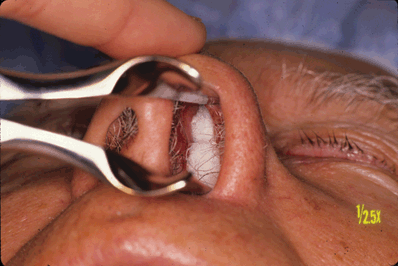
Figure 24-1. The bayonet forceps should be directed toward the medial canthus, placing the packing in the middle meatus, between the head of the middle turbinate and inferior turbinate. Proper placement of the packing within the nasal cavity is important because it not only serves to vasoconstrict and anesthetize the mucosa but also acts as a barrier to prevent inadvertent laceration of the nasal septum when the mucosa is incised. Excessive upward force during packing should be avoided to prevent perforation of the cribriform plate. A second strip of cotton gauze is inserted into the posterior nasal cavity to absorb the excess “pseudococaine” solution that may run toward the oropharynx. This is useful while operating on a conscious patient.

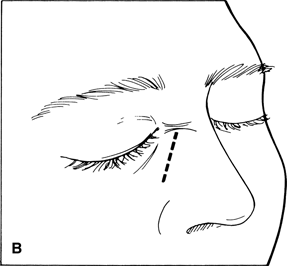
Figure 24-2A and B. A marking pen is used to outline the proposed incision site. The proposed skin incision is located midway between the medial canthal angle and the dorsum of the nose (asterisk). A line is drawn 10 to 12 mm nasal to the medial canthal angle, beginning at the level of the inferior edge of the medial canthal tendon, extending downward and laterally in a straight line toward the nasal alar fold for a distance of 1.5 cm. This incision is parallel to the angular vessels and lies within the thicker nasal skin. Do not curve the incision to involve the thinner eyelid skin as postoperative cicatricial contracture will result in a bowstring scar.
The patient is then prepared and draped while the surgeon scrubs. The face is left exposed to provide adequate access to the nose for nasal inspection and silicone stent retrieval during the procedure.
Skin incision
A skin incision over the preplaced marking is made with a size 15 Bard-Parker blade. The incision should be no deeper than the subcutaneous fascia. With the skin edges tented up by forceps, the remaining strands of superficial fascia are cut with Stevens scissors. All bleeding points and subcutaneous vessels are cauterized with a wet-field bipolar cautery.
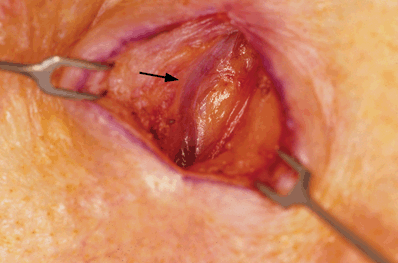
Figure 24-3. Frequently, the angular vessels (arrow) can be readily identified and retracted out of the surgical field with a rake retractor. If the angular vessels are inadvertently severed, it is best managed by ligating or cauterizing each end of the cut vessel.
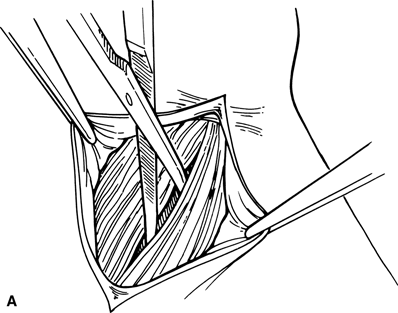

Figure 24-4A and B. A curved Stevens scissors penetrates the orbicularis muscle fibers just nasal to the anterior lacrimal crest, and the blades are spread vertically to expose the periosteum of the frontal process of the maxilla.
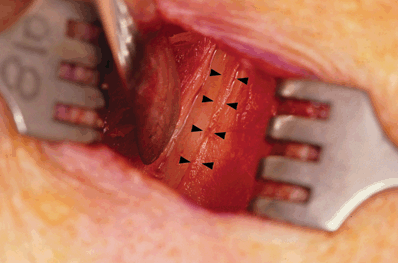
Figure 24-5. With the blunt rake retractors providing exposure, the periosteum is incised (edges outlined by arrowheads) 3 to 4 mm anterior and parallel to the crest with the sharp end of a Freer elevator. The periosteal incision extends from just below the medial canthal tendon to the inferior orbital rim.
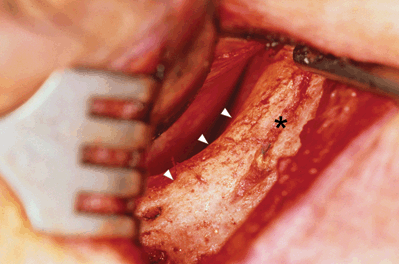
Figure 24-6. As the periosteum is reflected anteriorly (arrowheads), bony bleeding from the sutura notha (asterisk) is frequently encountered. The sutura notha, a small vascular groove situated 1 to 2 mm from the anterior lacrimal crest, is often mistaken for the edge of the crest. In this case, the surgeon will incorrectly begin rounding for the lacrimal fossa. Bleeding from the sutura notha may be controlled with bone wax. Once the anterior lacrimal crest is visualized, the surgeon should be cautious in rounding the edge. Care should be taken to avoid approaching the lacrimal sac in an uncontrolled fashion, or placing excess pressure on the lacrimal sac. The tip of the elevator may inadvertently lacerate the sac and cause bleeding. This will make flap anastomosis more difficult later in the procedure. The periosteum posterior to the crest is loosely adherent to the bone; the blunt end of the Freer elevator is used to reflect both the lacrimal sac and its periosteal lining laterally.
Stay updated, free articles. Join our Telegram channel

Full access? Get Clinical Tree


